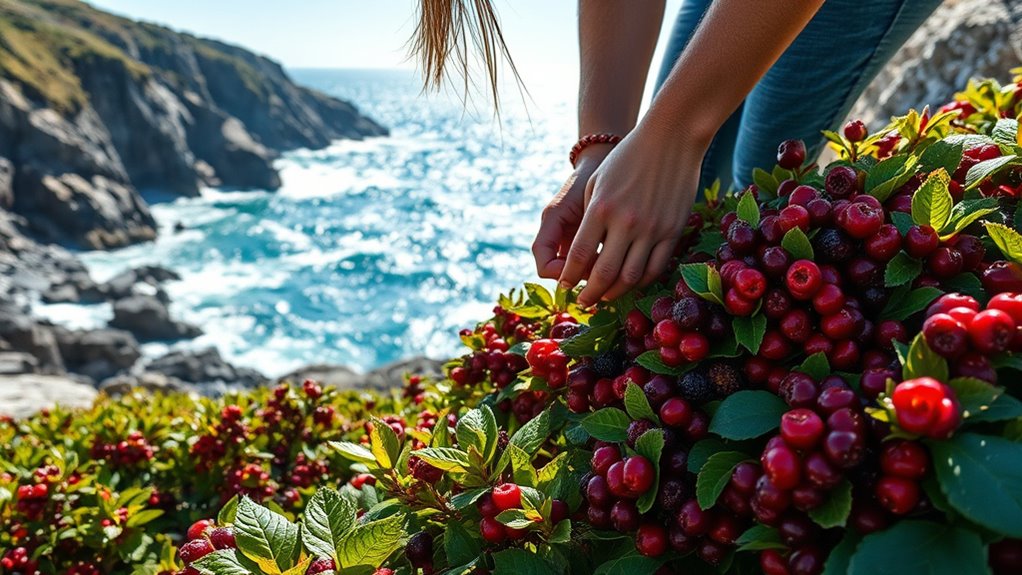When foraging for wild berries in coastal climates, make sure you can accurately identify edible varieties like salmonberries, huckleberries, and elderberries by using reliable guides. Always verify berry safety before consuming, harvest only ripe berries, and handle them gently. Respect local laws and avoid damaging plants or ecosystems. By being cautious and responsible, you can enjoy delicious, safe wild berries—learn more about proper foraging techniques and plant precautions to stay safe.
Key Takeaways
- Always identify berries using a reliable field guide or app before harvesting.
- Harvest only ripe, brightly colored berries that easily detach from the plant.
- Avoid eating berries from areas near roads, industrial sites, or unknown environments.
- Rinse berries gently under cold water and discard damaged or moldy ones.
- Follow local regulations, obtain permissions, and harvest sustainably to protect ecosystems.
Recognizing Edible Versus Toxic Berries
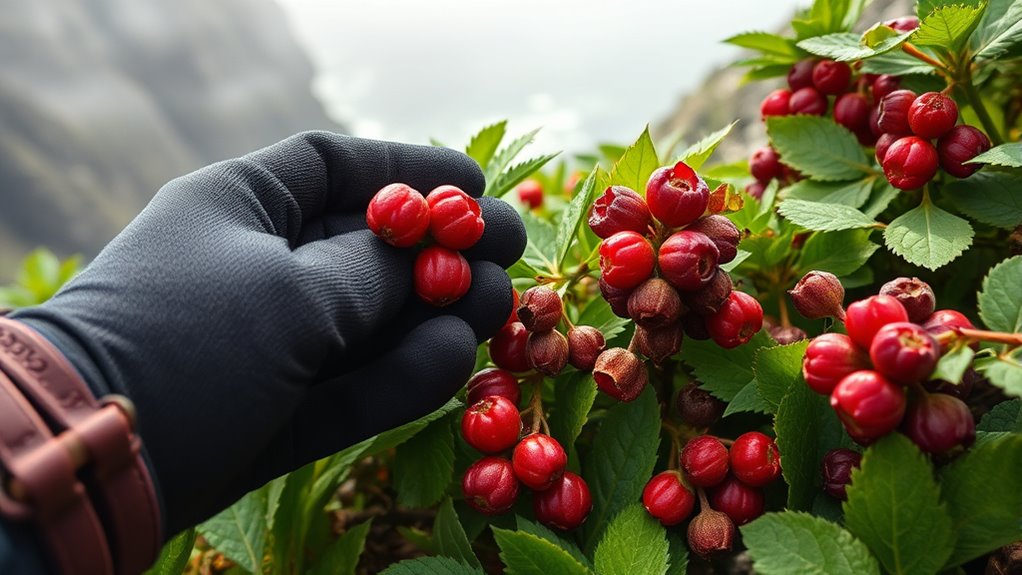
While many wild berries look similar, it’s crucial to learn how to distinguish between edible and toxic varieties before you start foraging. Pay attention to key features like color, shape, and size, but don’t rely on these alone. Many toxic berries mimic edible ones to trick foragers. Always check the plant’s leaves, stems, and growth patterns, as these can provide clues to its identity. Use a reliable field guide or app to verify your finds, and never eat a berry unless you’re 100% sure it’s safe. Remember, ingestion of even a small amount of toxic berries can cause serious health issues. When in doubt, discard suspicious berries to avoid accidental poisoning. Accurate identification is the cornerstone of safe foraging practices in coastal climates. Additionally, understanding the plant morphology can further aid in correctly identifying edible versus toxic species. Familiarity with edible berries and their distinguishing features is essential for responsible foraging, especially in diverse coastal environments. Being familiar with dog breeds that are friendly and observant can help when exploring outdoor environments safely.
Coastal Berry Species to Know
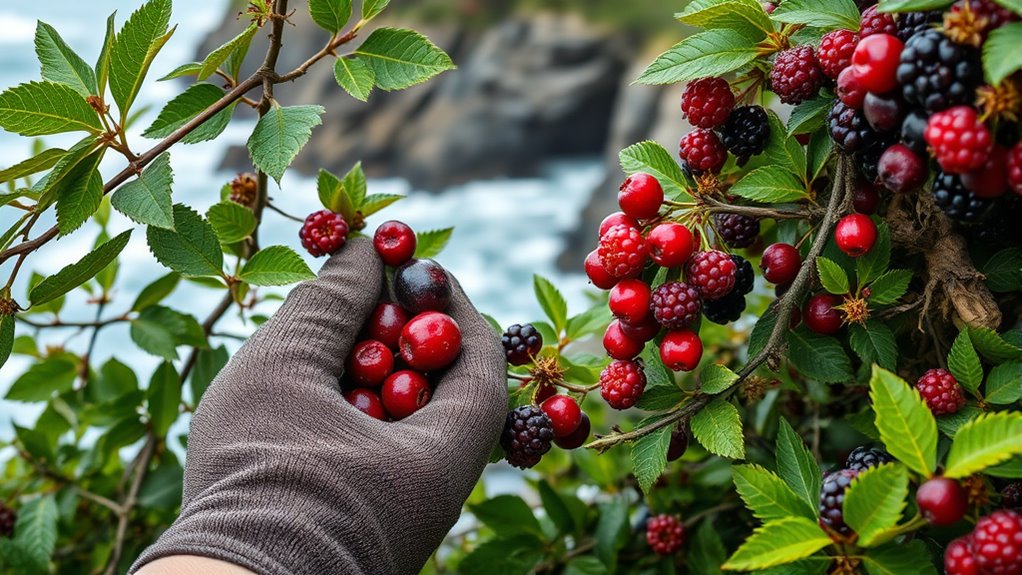
Coastal regions host a unique variety of wild berries that are well worth learning to identify. One common species is the Salmonberry, which has orange-pink bracts and resembles a raspberry but with a softer texture. Huckleberries thrive in coastal forests and are small, dark berries often mistaken for blueberries. Elderberries grow in clusters and feature dark purple, almost black berries with a tart flavor—be cautious, as raw elderberries can cause stomach upset. Thimbleberries, with their bright red, raspberry-like appearance, grow along forest edges and are easily recognizable. Coastal regions also host Oregon grapes, which produce blue-purple berries with a tart taste, often used in jellies. Familiarizing yourself with these species helps guarantee you forage safely while enjoying the diverse flavors of coastal berries. Additionally, understanding the toxicity risks associated with some wild berries ensures a safe foraging experience.
Tips for Safe Berry Harvesting
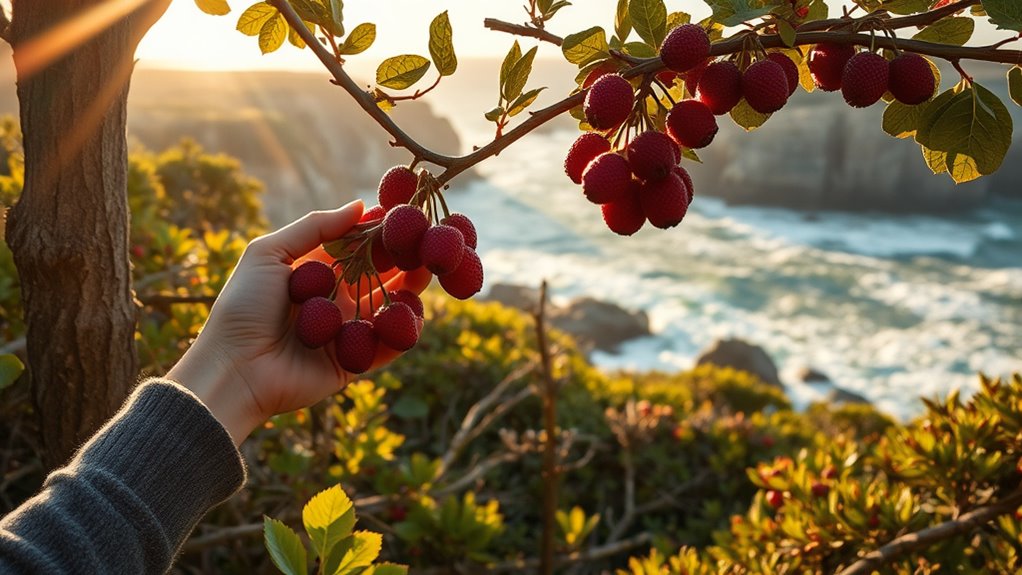
Are you confident in identifying safe berries before you harvest? Always double-check species before picking. Use a reliable field guide or app to confirm your identification, especially since many berries look similar. Harvest only ripe berries; they’re usually plump, brightly colored, and easy to detach. Avoid berries that are underripe, damaged, or have mold. Be mindful of your surroundings—stay away from areas near roads, industrial sites, and unknown plants, as they may be contaminated. Use clean, sharp tools or your hands to pick berries gently, minimizing damage to the plant. Proper watering practices can help ensure your investments are secure and well-managed. Additionally, staying aware of warning signs of environmental hazards can further protect your health while foraging. Always harvest in moderation to avoid overharvesting and damaging the plant population. Proper identification and understanding of safe foraging practices can help ensure your safety and the health of the environment. Remember, when in doubt, leave the berries untouched—safety always comes first.
Handling and Preparing Wild Berries
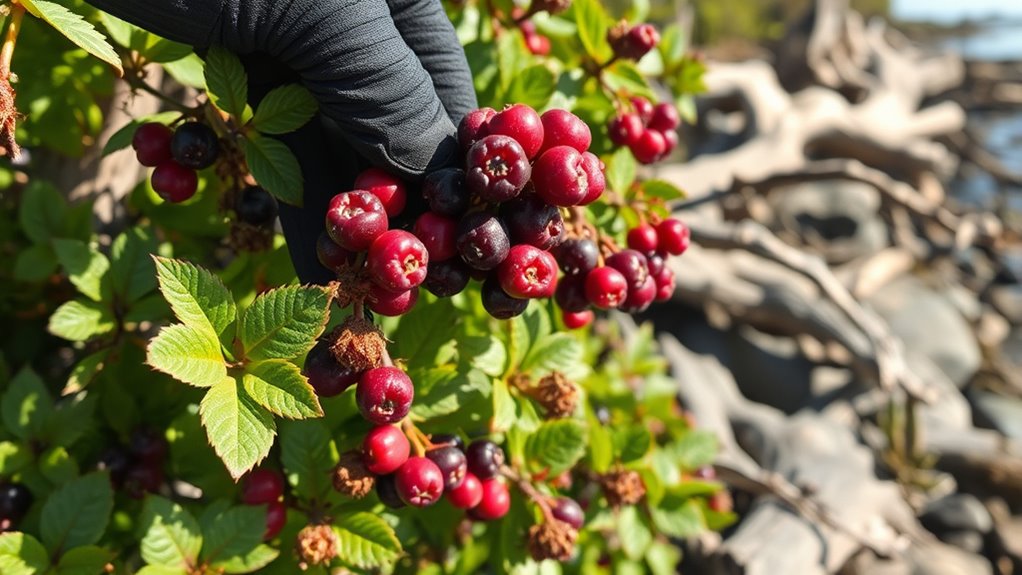
Once you’ve safely harvested your wild berries, proper handling and preparation are key to ensuring they’re safe to enjoy. Start by gently rinsing the berries under cold, running water to remove dirt, leaves, and insects. Avoid soaking them, as excess moisture can cause spoilage. After rinsing, spread the berries on a clean towel or paper towels to dry thoroughly. Inspect each berry carefully, discarding any that are moldy, damaged, or unripe. If you plan to store them, keep the berries in a breathable container in the refrigerator to prevent mold growth. For immediate use, you can prepare them by removing stems or stems and slicing if needed. Proper handling preserves flavor and reduces the risk of contamination, ensuring your wild berries are both safe and delicious. Additionally, being aware of symptoms of foodborne illness can help you identify if the berries have been contaminated and are unsafe to eat. Using HEPA filtration or other effective purification methods can help reduce airborne contaminants during processing, especially in environments with dust or allergens. Incorporating knowledge of food safety practices can further minimize risks associated with wild foraging. Being mindful of proper storage techniques also helps maintain the berries’ freshness and safety over time. Moreover, understanding processing techniques can enhance the safety and shelf life of your harvested berries.
Respecting Local Regulations and Ecosystems
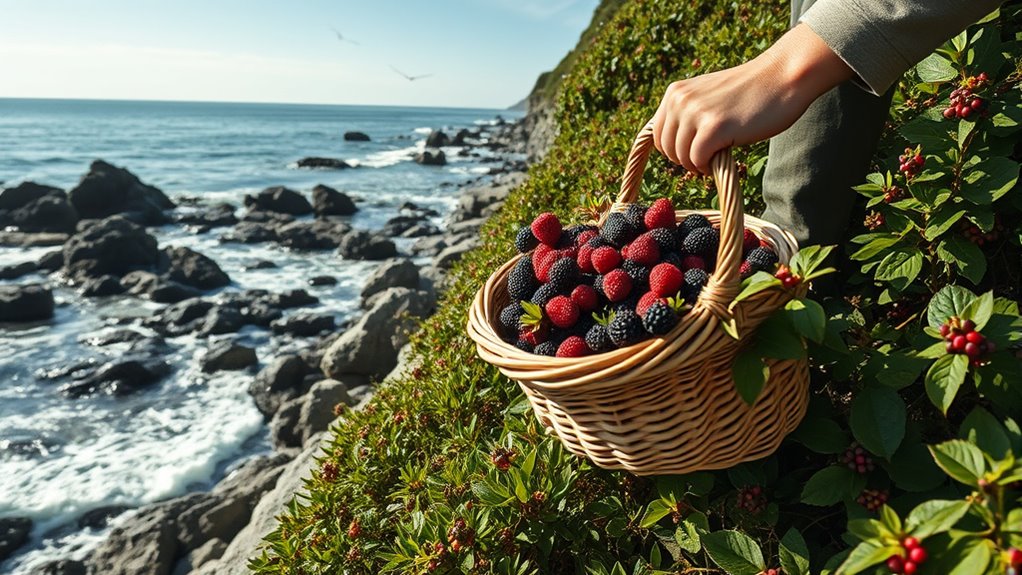
Respecting local regulations and ecosystems is essential when foraging for wild berries. You must follow laws that protect native plants and prevent overharvesting. Always check for permits or restrictions in your area. Respect private property by seeking permission before entering. To help ecosystems thrive, avoid damaging plants or disturbing wildlife. Visualize these boundaries with this table:
| Area Type | Important Rules | Impact on Ecosystem |
|---|---|---|
| Public Parks | Stay on designated trails | Protects native plants |
| Private Land | Obtain owner permission | Prevents legal issues |
| Protected Sites | No picking or disturbing flora | Preserves biodiversity |
| Coastal Areas | Limit harvest to sustainable levels | Maintains plant resilience |
| Nature Reserves | Follow posted guidelines | Supports ecosystem health |
Being aware of ecosystem health helps ensure that wild berry foraging remains sustainable for future generations. Additionally, understanding local regulations can prevent inadvertent violations that could harm the environment or result in legal penalties. Moreover, practicing responsible foraging ensures the longevity of wild berry populations and their habitats. Incorporating sustainable harvesting techniques can further minimize ecological impact and support long-term plant vitality. Developing a foraging plan that considers seasonal cycles and plant regeneration needs is also crucial for maintaining ecological balance.
Frequently Asked Questions
How Can I Tell if a Berry Is Ripe and Ready to Pick?
To determine if a berry is ripe, look for vibrant color—usually deep or bright shades specific to the species. Gently squeeze the berry; it should feel plump and firm but not hard. Smell the berry, as ripe ones emit a sweet aroma. Avoid berries that are underripe, dull, or have green patches. Trust your instincts and familiarize yourself with the specific berries you’re foraging to guarantee safety.
Are There Any Common Berry Allergies I Should Be Aware Of?
When you consider common berry allergies, you should be cautious of strawberries, raspberries, and blackberries, as some people react to their proteins. You might also be allergic to elderberries or gooseberries, which can cause symptoms like itching, swelling, or stomach upset. Always test new berries in small amounts first and consult an allergist if you’re unsure about your sensitivities. Being aware helps you enjoy foraging safely.
What Tools Are Best for Harvesting Wild Coastal Berries?
Surprisingly, the best tools for harvesting wild coastal berries aren’t high-tech gadgets but simple essentials. You’ll want a sturdy, lightweight basket or a pruning shears to gently snip berries without damaging plants. Gloves can safeguard you from thorns and irritants. A small, collapsible knife helps if you need to cut branches. Remember, gentle handling preserves the plants and ensures a fruitful foraging experience.
How Do Weather Conditions Affect Berry Safety and Edibility?
Weather conditions directly impact berry safety and edibility. Heavy rain can wash away surface contaminants but might also cause berries to mold or rot if they stay wet. Sun exposure can ripen berries quickly, but extreme heat can spoil them or cause them to dry out. Wind can damage plants, making berries more prone to decay. Always check recent weather patterns to guarantee berries are safe to harvest and eat.
Can Wild Berries Be Safely Frozen for Later Use?
Yes, you can safely freeze wild berries for later use. First, wash them gently to remove dirt and debris, then spread them out on a baking sheet to freeze individually. Once frozen, transfer the berries to airtight containers or freezer bags. This method prevents clumping and preserves flavor. Just remember to label and date them, so you know how long they’ve been stored.
Conclusion
Remember, correctly identifying berries is vital—misidentification can be deadly. Coastal climates host over 200 berry species, but only a few are safe to eat. Did you know that many toxic berries look nearly identical to edible ones? By following proper harvesting tips and respecting local regulations, you can enjoy wild berries safely while protecting delicate ecosystems. Stay informed, be cautious, and savor the natural bounty responsibly.

